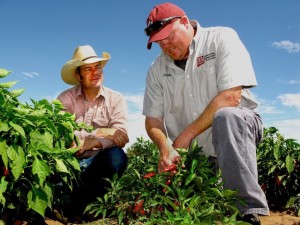New Mexico is known for its chile. The spicy vegetable is part of the state’s history, tradition and culture. There is even a state question – “Red or Green?”
As the chile industry strives to improve the chile pods for uniformity of size and shape, mechanical harvest and destemming, and food processing, there is a danger of the unique landrace chile varieties being lost.
New Mexico State University is conducting trials of 15 landrace varieties to establish a consumer guide that will categorize and describe the various traits of these chiles.
“Landrace chile varieties, including Chimayo, are a uniquely original New Mexico specialty crop,” said Stephanie Walker, NMSU Cooperative Extension Service vegetable specialist whose research studies many aspects of chile. “These varieties have been developed through many generations of selection by farming families in northern New Mexico and are recognized by consumers for their excellent quality.”
Landrace is a term used to describe heritage vegetable or fruit varieties from a specific geographical area. In New Mexico, families or communities have selected a variety of the chile that has distinct characteristic for their area.
“While these varieties are genetically distinct from commercial chile cultivars, there is evidence that cross-pollination has occurred between the landrace-types and commercial cultivars, potentially threatening the distinction of these varieties,” Walker said.
Graduate student Chuck Havlik, under the direction of Walker, is gathering data that will aid in categorizing and describing the different chile landraces. The chile landraces in the trial included Chimayo, Alcalde, Casados Native, Cochiti Pueblo, Escondida, Isleta Pueblo, Jarales, Jemez Pueblo, Puerta de Luna, San Felipe Pueblo, Santo Domingo Pueblo, Velarde and Zia Pueblo.
“Individuals and farming families have created excellent landrace chile varieties through many generations of selection and seed saving,” Havlik said. “As a preliminary step to protecting the uniformity of the different landrace chile varieties, collecting information documenting the unique attributes of each is critical.”
This information will be compiled in an Extension publication that will be available for use by growers in publicizing and selling their chile products. The replicated trials measured key quality components of the varieties that are providing a baseline description of each.
For more information on this, and other NMSU stories, visit the NMSU News Center.
